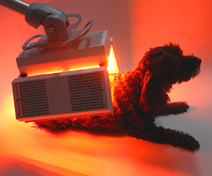
28.03.2019
Also for animals there is the whole phototherapeutic spectrum from violet to infrared for an extended therapy range in regeneration, traumatology, rheumatology, orthopedics, prevention and for vitality/performance.
We test the effectiveness of this method for skin diseases (including autoimmune and immune-mediated skin diseases), rheumatism, pain and all diseases predestined for PBM in small and large animals.
Different wavelengths influence different functions on the subcellular and cellular level. Violet light, for example, specifically affects keratinocytes and the Langerhans cells. It can activate coproporphyrin III, which can switch off Propionibacterium acnes. Blue light with a wavelength of 470 nm has a similar effect. Red light of 590 nm specifically acts on the endothelial cells of the superficial dermis Red light of 630 nm acts on the reticular fibre cells, which consist mainly of collagen and are formed by the reticulum cells. Red light can strengthen reticular connective tissue, invigorate lymphatic organs and support blood capillaries and muscle fibers. Red light also potentiates the effects of light of other biological wavelengths. For example, infrared light has a particularly modulating effect on mast cells, macrophages and neutrophil granulocytes and can positively influence the immune status.
Multi-spectral photobiomodulation - the simultaneous treatment with different wave lengths - has not yet been researched as deeply as laser therapy with monochromatic light of the red or infrared light spectrum. On the other hand, the feedback from practice is as promising as from the human field.
In the future, we will report on our results here.
Pictures:
Treatment with the Biophoton-Triwings, a modern multispectral brightLED therapy device
Image license: BIOPHOTON.fr